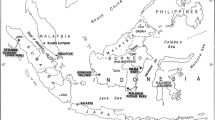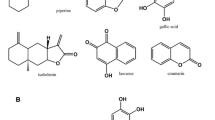Abstract
Termite mound soils eaten by chimpanzees of the Mahale Mountains and Gombe National Parks, Tanzania, have mineralogical and geochemical compositions similar to many soils eaten by higher primates, but release very low levels of either toxic or nutritional inorganic elements to solution at acid pH. Comparison with control (uneaten) soils from the same areas showed lower levels of carbon and nitrogen in the eaten soils, a relationship confirmed by surface analysis. Surface analysis also revealed lower levels of iron on particle surfaces versus interiors, and higher levels of iron on ingested versus control soil particle surfaces. The soils can adsorb dietary toxins, present in the plant diet or those produced by microorganisms. Taking the toxic alkaloids quinine, atropine, sparteine, and lupanine as examples, it is evident that soils from Mahale have a very good adsorptive capacity. A new adaptive advantage of geophagy is proposed, based on the prevention of iron uptake. The behavior of the soils in vitro is consistent with the theory that geophagy has a therapeutic value for these chimpanzees.
Similar content being viewed by others
REFERENCES
AUFREITER, S., HANCOCK, R. G. V., MAHANEY, W. C., STAMBOLIC-ROBB, A., and SANMUGADAS, K. 1997. Geochemistry and mineralogy of soils eaten by humans. Int. J. Food Sci. Nutr.48:229-242.
BERRESHEIM, K., MATTERN-KLOSSEN, N., and WILMERS, M. 1991. A standard form of spectra for quantitative ESCA analysis. Fresenius' Z. Anal. Chem.341:121-124.
BOLTON, K. A., CAMPBELL, V. M., and BURTON, F. D. 1998. Chemical analysis of soils of Kowloon (Hong Kong) eaten by hybrid rhesus macacques. J. Chem. Ecol.24:195-205.
BROUILLARD, M.-Y., and RATEAU, J.-G. 1989. Pouvoir d'asorption de deux argiles, la smectite et le kaolin sur des entérotoxines bactériennes. Gastroenterol. Clin. Biol.13:18-24.
BROWMAN, D. L., and GUNDERSON, J. N. 1993. Altiplano comestible earths: Prehistoric and historic geophagy of highland Peru and Bolivia. Geoarchaeology8:413-425.
COLLINS, D. A., and MCGREW, W. C. 1988. Habitats of three groups of chimpanzees (Pan troglodytes) in Western Tanzania compared. J. Hum. Evol.17:553-574.
CURRIE, C. R., SCOTT, J. A., SUMMERBELL, R. C., and MALLOCH, D. 1999. Fungus-growing ants use antibiotic bacteria to control garden parasites. Nature398:701-704.
DAVIES, A. G., and BAILLIE, I. E. 1988. Soil-eating by red leaf monkeys (Presbytis rubicunda) in Sabah, northern Borneo. Biotropica20:252-258.
DAY, P. E. 1965. Particle fractionation and particle size analysis, pp. 545-567, inC. A. Black (ed.). Methods of Soil Analysis. American Society of Agronomy, Madison, Wisconsin.
ETKIN, N. L., and ROSS, P. J. 1983. Malaria, medicine and meals: plant use among the Hausa and its impact on disease, pp. 231-359, inL. Romanucci-Ross, D. E. Moerman, and L. R. Tancredi (eds.). The Anthropology of Medicine: From Culture to Method. Praeger Scientific, J. F. Bergin, New York.
FOSSEY, D. 1974. Observations on the home range of one group of mountain gorilla (Gorilla gorilla beringei). Anim. Behav.22:568-581.
FOSSEY, D. 1983. Gorillas in the Mist. Houghton Mifflin, Boston.
GARDINER, K. R., ANDERSON, N. H., MCCAIGUE, M. D., ERWIN, P. J., HALLIDAY, M. I., and ROWLANDS, B. J. 1993. Adsorbents as antiendotoxin agents in experimental colitis. Gut34:51-55.
GATES, W. P., JAUNET, A.-M., TESSIER, D., COLE, M. A., WILKINSON, H. T., and STUCKI, J. W. 1998. Swelling and texture of iron-bearing smectites reduced by bacteria. Clays Clay Miner.46(5):487-497.
GEISSLER, P. W., MWANIK, D. L., THIONG'O, F., and FRILS, H. 1997. Geophagy among schoolchildren in western Kenya. Trop. Med. Int. Health2:624-630.
GEISSLER, P. W., MWANIKI, D. L., THIONG'O, F., MICHAELSEN, K. F., and FRILS, H. 1998. Geophagy, iron status and anemia among primary school children in Western Kenya. Trop. Med. Int. Health3:529-534.
GEISSLER, P. W., PRINCE, R. J., LEVENE, M., PODA, C., BECKERLEG, S. E., MUTEMI, W., and SHULMAN, C. E. 1999. Perceptions of soil-eating and anaemia among pregnant women on the Kenyan coast. Soc. Sci. Med.48:1069-1079.
GHIO, A. J., KENNEDY, T. P., WHORTON, A. R., CRUMBLISS, A. L., HATCH, G. E., and HOIDAL, J. R. 1992. Role of surface-complexed iron in oxidant generation and lung inflammation induced by silicates. Am. J. Physiol.263:L511-L518.
GILARDI, J. D., DUFFEY, S. S., MUNN, C. A., and TELL, L. A. 1999. Biochemical functions of geophagy in parrots: Detoxification of dietary toxins and cytoprotective effects. J. Chem. Ecol.25:897-922.
HANCOCK, R. G. V. 1978. Some aspects of the analysis of ancient artifacts by neutron activation. J. Int. Inst. Conserv. Can. Group3:21-27.
HANCOCK, R. G. V. 1984. On the source of clay used for Cologne Roman pottery. Archaeometry26:210-217.
HENRY, M., JOLIVET, J. P., and LIVAGE, J. 1990. Aqueous chemistry of metal cation: Hydrolysis, condensation, and complexation. Struct. Bonding25:1-64.
HEYMANN, E. W., and HARTMANN, G. 1991. Geophagy in moustached tamarins, Sagiunus mystax(Platyrrhini: Callitrichidae), at the Rio Blanco, Peruvian Amazonia. Primates32:533-537.
HLADIK, C. M. 1977. A comparative study of the feeding strategies of two sympatric species of leaf monkeys: Presbytis senexand Presbytis entellus, pp. 481-501, inT. H. Clutton-Brock (ed.). Primate Ecology: Studies of Feeding and Ranging Behaviour in Lemurs, Monkeys and Apes. Academic Press, New York.
HLADIK, C. M., and GUEGUEN, L. 1974. Géophagie et nutrition minérale chez les primates sauvages. C.R. Acad. Sci. Paris Ser. D.279:1393-1396.
HUFFMAN, M. A. 1997. Current evidence for self-medication in primates: A multidisciplinary perspective. Yearb. Phys. Anthropol.40:171-200.
HUNTER, J. M. 1973. Geophagy in Africa and in the United States: A culture-nutrition hypothesis. Geogr. Rev.63:170-195.
IZAWA, K. 1993. Soil-eating by Alouattaand Ateles. Int. J. Primatol.14:229-242.
JOHNS, T. 1990. With bitter herbs shall they eat it: Chemical ecology and the origin of human diet and medicine. University of Arizona Press, Tucson.
JOHNS, T., and DUQUETTE, M. 1991. Detoxification and mineral supplementation as functions of geophagy. Am. J. Clin. Nutr.53:448-456.
JULLIOT, C., and SABATIER, D. 1993. Diet of the red howler monkey (Alouatta seniculus) in French Guiana. Int. J. Primatol.14:527-549.
KETCH, L. A. 1998. Microbiological investigations of geophagy in chimpanzees. MSc. thesis. University of Toronto, Toronto.
KNEZEVICH, M. 1998. Geophagy as a therapeutic mediator of endoparasitism in a free-ranging group of rhesus macaques (Macaca mulatta). Am. J. Primatol.44:71-82.
KORTLAND, A. 1984. Habitat richness, foraging range and diet in chimpanzees and some other primates, pp. 119-159, inD. J. Chivers, B. A. Wood, and A. Bilsborough, (eds.). Food acquisition and processing in primates. Plenum Press, New York.
LAUFER, B. 1930. Geophagy. Anthropology Series XVIII. Field Museum of Natural History.
MAHANEY, W. C. 1990. Glacially crushed quartz grains in Late Quaternary deposits in the Virunga Mountains, Rwanda-indicators of wind transport from the north. Boreas19:81-89.
MAHANEY, W. C. 1999. Paleoclimate and paleonutrition-paleozoopharmacognosy: A timely connection. Frankf. Geowiss. Arb. Ser.25:123-134.
MAHANEY, W. C., WATTS, D. P., and HANCOCK, R. G. V. 1990. Geophagia by mountain gorillas (Gorilla gorilla beringei) in the Virunga Mountains, Rwanda. Primates31:113-120.
MAHANEY, W. C., HANCOCK, R. G. V., and AUFREITER, S. 1995. Mountain gorilla geophagy: A possible strategy for dealing with intestinal problems. Int. J. Primatol.16:475-488.
MAHANEY, W. C., HANCOCK, R. G. V., AUFREITER, S., and HUFFMAN, M. A. 1996. Geochemistry and clay mineralogy of termite mound soil and the role of geophagy in chimpanzees of the Mahale Mountains, Tanzania. Primates37:121-134.
MAHANEY, W. C., MILNER, M. W., SANMUGADAS, K., HANCOCK, R. G. V., AUFREITER, S., WRANGHAM, R., and PIER, H. W. 1997. Analysis of geophagy soils in Kibale Forest, Uganda. Primates38:159-176.
MAHANEY, W. C., ZIPPIN, J., MILNER, M., SANMUGADAS, K., HANCOCK, R. G. V., AUFREITER, S., CAMPBELL, S., HUFFMAN, M. A., WINK, M., MALLOCH, D., and KALM, V. 1999. Chemistry, mineralogy and microbiology of termite mound soil eaten by the chimpanzees of the Mahale Mountains, Western Tanzania. J. Trop. Ecol.15:565-588.
MCCONNELL, R. B. 1950. Outline of the geology of Ufipa and Ubende. Bull. Geol. Surv. Tanganyika19.
MEEROVITCH, E. 1982. The jigsaw puzzle of host-parasite relations in amoebiasis begins to take shape, pp. 263-173, inE. Meerovitch (ed.). Aspects of Parasitology, A Festschrift Dedicated to the Fiftieth Anniversary of the Institute of Parasitology of McGill University. Institute of Parasitology, McGill University, Montreal.
MINNICH, V., OKCUO LU, A., TARCON, Y., ARCASOV, A., CIN, S., YöRüKO LU, O., RENDA, F., and DEMIRA , B. 1968. Pica in Turkey II. Effect of clay upon iron absorption. Am. J. Clin. Nutr.21:78-86.
MULLER, K.-H., AHL, C., and HARTMANN, G. 1997. Geophagy in masked titi monkeys (Callicebus personatusmelanochir) in Brazil. Primates30:69-77.
NISHIDA, T. 1990. A quarter century of research in the Mahale Mountains: An overview, pp. 3-35, inT. Nishida (ed.). The Chimpanzees of the Mahale Mountains: Sexual and Life History Strategies. The University of Tokyo, Tokyo.
OATES, J. F. 1977. The guereza and its food, inT. H. Clutton-Brock, (ed.). Primate Ecology: Studies of Feeding and Ranging Behaviour in Lemurs, Monkeys and Apes. Academic Press, New York.
OATES, J. F. 1978. Water-plant and soil consumption by guereza monkeys (Colobus guereza): A relationship with minerals and toxins in the diet Biotropica10:241-253.
OYAMA, M., and TAKEHARA, H. 1970. Standard soil color chart. Japan Research Council for Agriculture, Forestry and Fisheries.
POIRIER, F. E. 1970. The nilgiri langur (Presbytis johnii) of South India, pp. 251-383, inL. A. A. Rosenblum, (ed.). Primate Behaviour: Developments in Field and Laboratory Research, Vol. 1. Academic Press, New York.
POLLITT, E. 1993. Iron deficiency and cognitive function. Annu. Rev. Nutr.13:521-537.
RATEAU, J.-G., MORGANT, G., DROY-PRIOT, M.-T., and PARIER, J.-L. 1982. A histological, enzymatic and water-electrolyte study of the action of smectite, a mucoprotective clay, on experimental infectious diarrhea in the rabbit. Curr. Med. Res. Opin.8:233-241.
REICHENAU, E. 1920. Den Wiederkauer-Infusiorien verwandte Formen aus Gorilla und Schimpansen. Arch. Protistenkd.41:1-33.
SAID, S. A., SHIBL, A. M., and ABDULLAH, M. E. 1980. Influence of various agents on absorption capacity of kaolin for Pseudomonas aeruginosatoxin. J. Pharm. Sci.69:1238-1239.
SODHI, R. N. S., GRAD, H. A., and SMITH, D. C. 1992. Examination by X-ray photoelectron spectroscopy of the adsorption of chlorhexidine on hydroxyapatite. J. Dent. Res.71:1493-1497.
STAMBOLIC-ROBB, A. 1997. Geophagy amongst free ranging Sumatran orangutans (Pongo pygmaeus abelii) of Gunung Leuser National Park and ex-captive Bornean orangutans (Pongo pygmaeus pygmaeus) of Sungai Wain Forest, Indonesia. MSc thesis. York University, Toronto.
TUOMAINEN, T.-P., NYYSSöNEN, K., PORKKALA-SARATAHO, E., SALONEN, R., BAUMGARTNER, J. A., GEISSER, P., and SSALONEN, J. T. 1999. Oral supplementation with ferrous sulfate but not with non-ionic iron polymaltose complex increases the susceptibility of plasma proteins to oxidation. Nutr. Res.19:1121-1132.
UEHARA, S. 1982. Seasonal changes in the techniques employed by wild chimpanzees in the Mahale Mountains, Tanzania, to feed on termites (Pseudacanthotermes spiniger). Folia Primatol.37:44-76.
VORTISCH, W., MAHANEY, W. C., and FECHER, K. 1987. Lithology and weathering in a paleosol sequence on Mount Kenya. Geol. Paleontol.21:245-255.
WATTS, D. P. 1984. Composition and variability of mountain gorilla diets in the central Virungas. Am. J. Primatol.7:323-356.
WEINBERG, E. D. 1974. Iron and susceptibility to infectious disease. Science184:952-956.
WHITTIG, L. D. 1965. X-ray diffraction techniques for numerical identification and mineralogical composition, pp. 671-696, inC. A. Black, (ed.). Methods of Soil Analysis. American Society of Agronomy, Madison, Wisconsin.
WILEY, S. A., and KATZ, H. S. 1998. Geophagy in pregnancy: A test of a hypothesis. Curr. Anthropol.39(4):532-545.
WINK, M. 1993a. Allelochemical properties and the raison d'ê tre of alkaloids, 43:1-118, inG. Cordell (ed.). The Alkaloids. Academic Press, London.
WINK, M. 1993b. Quinolizidine alkaloids, pp. 197-329, inP. Waterman, (ed.). Methods in Plant Biochemistry. Academic Press, London.
WINK, M., HOFER, A., BILFINGER, M., ENGLERT, E., MARTIN, M., and SCHNEIDER, D. 1993. Geese and plant dietary allelochemicals-food palatability and geophagy. Chemoecology4:93-107.
WINK, M., MEISSNER, C., and WITTE, L. 1995. Patterns of quinolizidine alkaloids in 56 species of the genus Lupinus. Phytochemistry38:139-153.
Author information
Authors and Affiliations
Rights and permissions
About this article
Cite this article
Aufreiter, S., Mahaney, W.C., Milner, M.W. et al. Mineralogical and Chemical Interactions of Soils Eaten by Chimpanzees of the Mahale Mountains and Gombe Stream National Parks, Tanzania. J Chem Ecol 27, 285–311 (2001). https://doi.org/10.1023/A:1005628405321
Issue Date:
DOI: https://doi.org/10.1023/A:1005628405321




